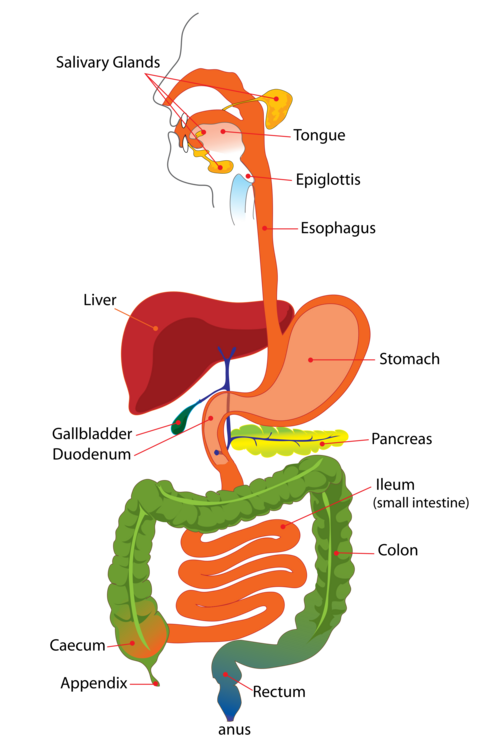The Organ Systems/digestive
The Digestive System
Function of system:
The function of the digestive system is to breakdown the food into small molecules, which are then absorbed into the body.
How it aids in homeostasis:
It maintains the balance by providing the energy necessary to keep functioning, as well as providing raw materials for growth.
Image of system:
Major organs:
Food enters through the mouth and is broken down physically by the teeth and tongue. Saliva secreted by the salivary glands contain the enzyme Amylase which breaks down starches.
The esophagus has a upper esophageal sphincter(UES) which is a group of muscle at the top of the esophagus. It controls eating, breathing, belching and vomiting. The UES also makes sure food doesn't go down the windpipe by way of the epiglottis, a flap that covers the opening to the trachea (windpipe) when food is being eaten.The second part of the esophagus is called the lower esophageal sphincter and its a ground of muscles at the bottom end of the esophagus. The lower esophageal sphincter prevents acid and the contents of the stomach from traveling up it.
The stomach is a cavity with strong muscles. It is where much of the physical breakdown of food takes place. The stomach secretes stomach acids and the enzyme pepsin which chemically breaks down proteins.
The Pancreas makes digestive enzymes that coat the food as it emerges from the stomach through the Pyloric sphincter. The enzymes chemically break down food into smaller molecules that can more easily be absorbed into the body.
The Gall Bladder stores bile which breaks apart fats making them easier to digest. The bile is made by the liver.
Partially digested food goes from the stomach into the small intestine. In the first part of the small intestine, the duodenum, food is combined with bile that comes from the gallbladder and enzymes from the pancreas. Food is moved through the intestines by muscles where it is absorbed into the blood stream after passing through the thin largely wrinkled inner surface or mucosa.
The large intestine absorbs water and salts and prepares waste material for excretion via the rectum and anus. It also houses a large number of microorganisms which aid in digestion and produce vitamin K.
The intestines are contained within a membranous sack called the Mesentery which attaches them to the abdominal wall and includes the blood vessels that feed them.
Comparative anatomy with three other phyla in kingdom:
All chordates a stomach and mouth and intestines for digestion.
Sources:
"Chordata Digestive System." Study.com. N.p., n.d. Web. 11 Apr. 2017.
"What Are the Main Organs of the Digestive System?" Reference. N.p., n.d. Web. 11 Apr. 2017.
"Function of the Digestive System." Function of the Digestive System. N.p., n.d. Web. 11 Apr. 2017.
"www.sciencealert.com/it-s-official-a-brand-new-human-organ-has-been-classified May 2017.
Return to Table of Contents


